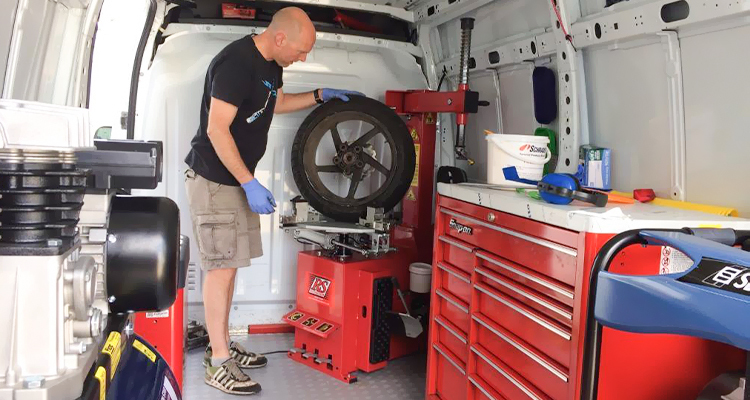Convenient Mobile Tire Service in Las Vegas at Your Doorstep
Convenient Mobile Tire Service in Las Vegas at Your Doorstep
Blog Article
Tire Service: Proven Approaches for Ideal Tire Maintenance and Care
Keeping optimum tire condition is critical for both safety and security and efficiency of any vehicle. From ensuring correct tire pressure to regular turning and positioning, there are proven techniques that can significantly expand the lifespan of your tires and improve overall driving experience. As we discover the ins and outs of tire care and upkeep, we will reveal necessary standards that every car proprietor need to abide by for the best feasible results. Allow's explore the world of tire service and discover the tricks to maintaining your tires in first-class shape for the long haul.
Relevance of Tire Stress
Proper tire stress is a crucial consider making certain optimal vehicle performance and safety on the road. Maintaining the recommended tire stress degrees given by the supplier uses countless advantages. To start with, sufficient tire pressure promotes far better gas effectiveness, as under-inflated tires can result in enhanced rolling resistance, triggering the engine to function harder and consume more fuel. Second of all, proper tire stress guarantees also walk wear, enhancing tire durability and saving money in the long run by delaying the need for early replacements. Furthermore, correctly pumped up tires contribute to improved handling and braking capabilities, crucial for safe driving in different road problems. Over-inflated tires, on the other hand, can result in reduced traction and a harsher ride. On the other hand, under-inflated tires are vulnerable to overheating, which can bring about blowouts and accidents. Regularly changing and inspecting tire pressure, specifically eventually journeys, is a basic yet efficient means to improve vehicle efficiency, prolong tire life-span, and prioritize safety when driving.
Tire Rotation Guidelines
When taking into consideration tire turning standards, it is essential to understand the significance of this upkeep job in maximizing tire lifespan and preserving ideal car efficiency. Tire rotation entails transforming the placement of each tire on an automobile to ensure even tread wear. Front tires often tend to wear quicker than rear tires due to guiding pressures, making routine rotation essential for balanced wear patterns. The suggested turning pattern varies relying on whether a lorry is front-wheel, rear-wheel, all-wheel, or 4x4. Generally, tires must be revolved every 5,000 to 7,500 miles, or as advised in the car handbook. Ignoring tire turning can bring about uneven wear, influencing handling, traction, and possibly compromising automobile safety. By sticking to proper turning guidelines, chauffeurs can expand the life of their tires, enhance fuel performance, and boost general driving experience. Regular turning is a straightforward yet effective upkeep practice that adds substantially to tire longevity and lorry performance.

Benefits of Wheel Placement
Ensuring proper wheel positioning after tire rotation is important for preserving well balanced wear patterns and making the most of car efficiency. Additionally, appropriate wheel positioning aids to extend the lifespan of your tires. Misaligned wheels can create unequal tire wear, leading to premature tire replacement and enhanced maintenance prices.

Tire Footstep Deepness Inspect
Doing a regular inspection of tire step depth is essential for keeping risk-free driving conditions and lengthening the life expectancy of your tires. Irregular walk wear can indicate concerns with tire suspension, stress, or positioning, highlighting the importance of regular step depth checks. By including tire walk deepness checks right into your routine maintenance schedule, you can drive with self-confidence recognizing that your tires are in leading condition.
Seasonal Tire Inspection
A detailed evaluation of tire problem customized to certain climate condition is critical for maintaining optimal performance and security throughout the year. Seasonal tire assessment is a basic facet of tire upkeep that makes sure tires prepare to face the difficulties postured by different weather. In prep work for winter season, it is vital to examine the tire pressure routinely as cold temperature levels can create tire pressure to go down. Examining tire walk deepness is additionally vital to guarantee appropriate grip on snow and visit this site ice-covered roadways. In addition, looking for indications of deterioration, such as fractures or bulges, can aid protect against possible tire failings. As the seasons change, it is very important to assess tire condition and make any kind of essential modifications to ensure safe driving. By performing regular seasonal tire evaluations, vehicle drivers can prolong tire life expectancy, boost fuel effectiveness, and most importantly, make certain a safe driving experience in varying climate condition - Flat Tire Repair Las Vegas.
Final Thought
In final thought, maintaining correct tire stress, revolving tires consistently, aligning wheels correctly, monitoring tread depth, and conducting seasonal inspections are crucial methods for optimum tire care. By adhering to these verified methods, vehicle drivers can ensure their tires last much longer, perform far better, and add to total car safety and security. It is crucial to prioritize tire maintenance to stop crashes, enhance fuel efficiency, and prolong the life-span of tires.
Ample tire pressure navigate to this site promotes better gas efficiency, as under-inflated tires can lead to enhanced rolling resistance, creating the engine to function harder and consume more fuel.When considering tire rotation standards, it is important to comprehend the value of about his this upkeep job in making the most of tire life-span and keeping optimum vehicle performance. Seasonal tire evaluation is an essential facet of tire maintenance that guarantees tires are prepared to face the obstacles presented by various climate problems. By conducting routine seasonal tire examinations, vehicle drivers can lengthen tire lifespan, improve gas efficiency, and most importantly, ensure a safe driving experience in differing weather conditions.
In final thought, preserving appropriate tire pressure, turning tires on a regular basis, aligning wheels properly, keeping an eye on walk depth, and performing seasonal inspections are necessary techniques for optimal tire care.
Report this page